|
Battle of Cedar Creek, Virginia
Battle of Cedar Creek
Other Names: Belle Grove
Location: Frederick County, Shenandoah County and Warren County,
Virginia
Campaign: Sheridan's Shenandoah Valley Campaign (August-October 1864)
Date(s): October 19, 1864
Principal Commanders: Maj. Gen. Horatio Wright and Maj. Gen.
Philip Sheridan [US]; Lt. Gen. Jubal Early [CS]
Forces Engaged: 52,945 total (US 31,945; CS 21,000)
Estimated Casualties: 8,575 total (US 5,665; CS 2,910)
Result(s): Union victory
Description: At dawn, October 19, 1864, the Confederate Army
of the Valley under Lt. Gen. Jubal A. Early surprised the Federal army at Cedar Creek and routed the VIII and XIX Army Corps.
Commander Maj. Gen. Philip Sheridan arrived from Winchester to rally his troops, and, in the afternoon, launched a crushing
counterattack, which recovered the battlefield. Sheridan’s victory at Cedar Creek broke the back of the Confederate
army in the Shenandoah Valley. Lincoln rode the momentum of Sheridan’s victories in the Valley and Sherman’s successes
in Georgia to re-election.
| Battle of Cedar Creek Map |
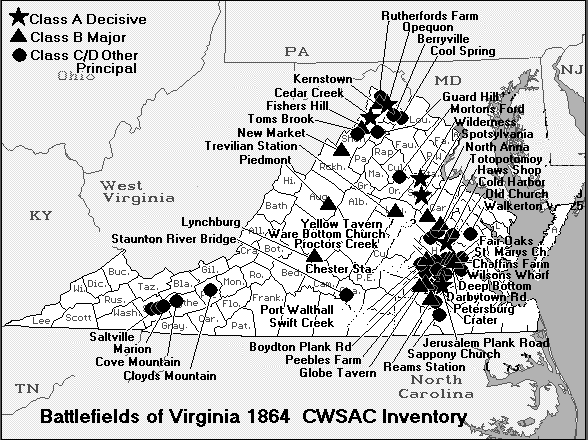
|
| Civil War Cedar Creek Battlefield Map |
| Civil War Battle of Cedar Creek |
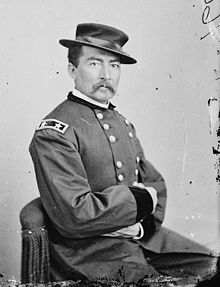
|
| Union Gen. Phil Sheridan |
Introduction:
The last great battle of the Civil War in the Shenandoah Valley of Virginia took place on October 19, 1864, along Cedar Creek
between the towns of Strasburg and Middletown. It marked the end of Confederate power in the Valley, and its timing three
weeks before the national elections unquestionably influenced the magnitude of President Lincoln's reelection. Despite this
significance, the battle has been buried in the legend of Philip H. Sheridan's famous ride from Winchester and the controversy
over Jubal Early's lost victory. The land over which the battle raged is still nearly the same as it was in 1864, yet few
people visiting it are even aware that a battle took place. This work is intended to introduce the Battle of Cedar Creek to
those not yet aware and help those already interested to better understand the history which took place over this quiet farmland.
The Battle of Cedar Creek, or
Battle of Belle Grove, fought October 19, 1864, was the culminating battle of the Valley Campaigns of 1864 during the American
Civil War. Confederate Lt. Gen. Jubal Early launched a surprise attack against the encamped army of Union Maj. Gen. Philip
Sheridan, across Cedar Creek, northeast of Strasburg, Virginia. During the morning fighting, seven Union infantry divisions
were forced to fall back and lost numerous prisoners and cannons. Early failed to continue his attack north of Middletown
and Sheridan, dramatically riding to the battlefield from Winchester, was able to rally his troops to hold a new defensive
line. A Union counterattack that afternoon routed Early's army.
The final Confederate invasion
of the North, furthermore, effectively ended. The Confederacy was never again able to threaten Washington, D.C., through the
Shenandoah Valley, nor protect one of its key economic bases in Virginia. The stunning Union victory aided the reelection
of Abraham Lincoln and Sheridan won lasting fame.
Two future Presidents of the
United States fought at the Battle of Cedar Creek. Col. Rutherford B.
Hayes, who commanded the second division of Gen. George Crook’s VIII Corps was elected the nineteenth President of the
United States in 1876. He served one term. Capt. William McKinley, who performed staff duties with the VIII Corps at the battle
of Cedar Creek, was elected the twenty-fifth President of the United States in 1896. He was shot on September 6, 1901, at
the Pan American Exposition in Buffalo, New York. He died eight days later.
| American Civil War in 1864 Map |
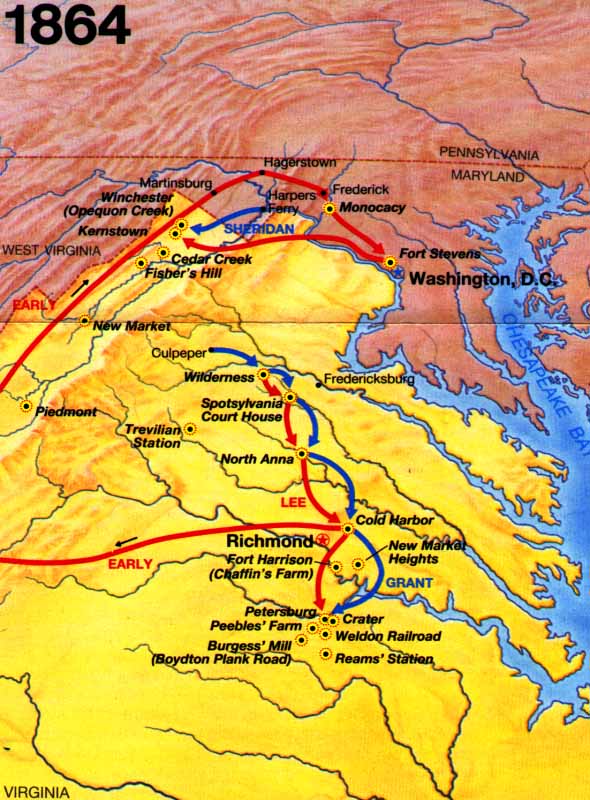
|
| Battle of Cedar Creek, Virginia |
| Battle of Cedar Creek History |
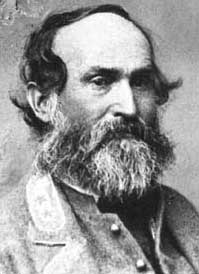
|
| Gen. Jubal Early |
Setting the Stage: At the beginning of 1864, Ulysses
S. Grant was promoted to lieutenant general and given command of all Union armies. He chose to make his headquarters with
the Army of the Potomac, although Maj. Gen. George G. Meade remained the actual commander of that army. He left Maj. Gen.
William Tecumseh Sherman in command of most of the western armies. Grant understood the concept of total war and believed,
along with Sherman and President Abraham Lincoln, that only the utter defeat of Confederate forces and their economic base
would bring an end to the war. Therefore, scorched earth tactics would be required in some important theaters. He devised
a coordinated strategy that would strike at the heart of the Confederacy from multiple directions: Grant, Meade, and Maj.
Gen. Benjamin Butler against Robert E. Lee's Army of Northern Virginia near Richmond; Sherman to invade Georgia and capture
Atlanta; and Maj. Gen. Nathaniel Banks to capture Mobile, Alabama.
Early's Campaign: Gen. Robert E. Lee, whose Army
of Northern Virginia was being maneuvered by Grant into a siege around Richmond and Petersburg, was also concerned about Hunter's
advances in the Valley. He sent his Second Corps, now designated the Army of the Valley, under Jubal Early to sweep Union
forces from the Valley and, if possible, to menace Washington, D.C., hoping to compel Grant to dilute his forces around Petersburg.
Early was operating in the shadow of Thomas J. "Stonewall" Jackson, whose 1862 Valley Campaign against superior forces was
fabled in Confederate history.
Early had a good start. He drove down the Valley without opposition, bypassed Harpers Ferry, crossed the Potomac
River, and advanced into Maryland. Grant dispatched a corps under Maj. Gen. Horatio G. Wright and other troops under Crook
to reinforce Washington and pursue Early. Early defeated a smaller force under Maj. Gen. Lew Wallace in the Battle of Monocacy
on July 9, but this battle delayed his progress enough to allow time for reinforcing the defenses of Washington. Early attempted
some tentative attacks against Fort Stevens (July 11–12) on the northern outskirts of Washington, but then withdrew
to Virginia. A number of small battles ensued as the Union pursued, including the defeat of Crook at the Second Battle of
Kernstown on July 24.
Sheridan's Campaign: Grant decided Early's threat had to be eliminated—particularly in the
wake of a cavalry raid that burned Chambersburg. He saw that Washington had to be heavily defended if Early was still on the
loose. One problem was that Early's moves cut through four federal departments. Grant considered unity of command to be essential
and recommended George Meade for the position, but Lincoln vetoed that because Radicals had launched a major political attack
on Meade. Grant's next choice was a man aggressive enough to defeat Early: Philip Sheridan, the cavalry commander of the Army
of the Potomac. Sheridan took command of all forces in West Virginia, western Maryland, and the Shenandoah Valley, the Middle
Military Division; his field army was called the Army of the Shenandoah. Sheridan initially started slowly, primarily because
the impending presidential election of 1864 demanded a cautious approach, avoiding any disaster that might lead to the defeat
of Abraham Lincoln.
| Battle of Cedar Creek |
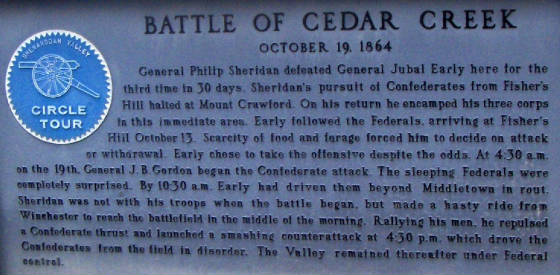
|
| Civil War Cedar Creek History |
The Battle of Cedar Creek was one of several battles fought during
Sheridan's
Valley Campaign (August – October 1864). Sheridan's Valley Campaign, part of the Shenandoah Valley Campaigns of 1864, was the last of three principal campaigns fought throughout the valley
region.
Sheridan's Valley Campaign [August-October 1864] witnessed the following battles:
Guard Hill – Summit Point – Smithfield Crossing – Berryville – 3rd Winchester – Fisher's Hill – Tom's Brook – Cedar Creek.
Opposing Commanding Generals:
Major General Philip H. Sheridan
(1831-1888), commander of the Union forces at Cedar Creek, began the war as a first lieutenant in the infantry. Appointed
Colonel, Second Michigan Cavalry, in May 1862, his brilliant performance led to command of a brigade and promotion within
a month. In September 1862 he was given command of an infantry division. The performance of his tightly controlled and aggressive
unit led to Sheridan's promotion to major general in December 1862.
Lieutenant General Jubal A.
Early (1816-1894) commanded the Confederate army at Cedar Creek. He graduated from the U.S. Military Academy in 1837 and practiced
law before entering Confederate service as a colonel, 24th Virginia Infantry, in April 1861. A division commander by 1862
and corps commander by 1864, Early was a superb, aggressive division commander. In corps command, however, he tended to commit
assets piecemeal and never showed much understanding of the uses of cavalry.
| Sheridan's Campaign Map (August - October 1864) |
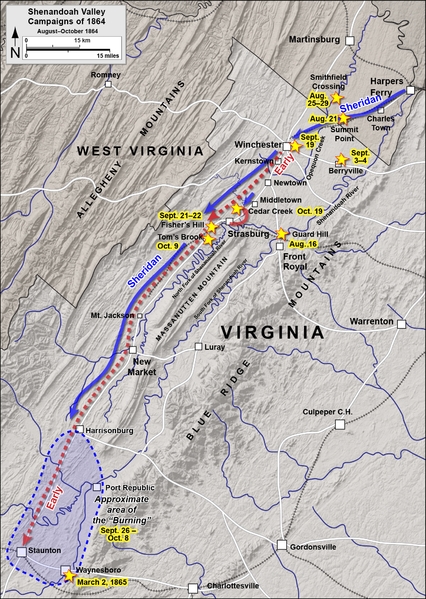
|
| Battle of Cedar Creek Map |
| Shenandoah Valley Campaign Map (May - July 1864) |
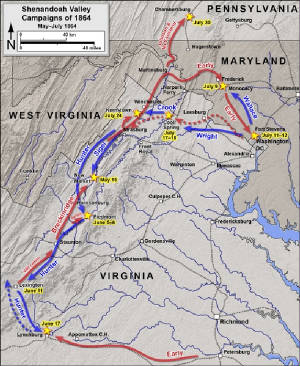
|
| Civil War Cedar Creek Battle Map |
Battle: Early's
men began preparing three columns on the evening of October 18. Gordon's column (the divisions of Ramseur, Pegram, and Evans),
with the farthest to march, departed just after it became dark, about 8 p.m. They stealthily followed a narrow path (a "pig
path") between the Shenandoah and the nose of Massanutten Mountain, previously scouted by Gordon and mapmaker, Maj. Jedediah
Hotchkiss. The path required single file passage in places, and did not support the movement of artillery. The columns of
Wharton and Kershaw departed at about 1 a.m. on October 19, and all three columns of infantry were in position by 3:30 a.m.
Rosser's cavalry prepared to advance along the western side of the valley to attack in the vicinity of Cupp's Ford. (The 300-man
cavalry brigade of Col. William H. Payne, Rosser's division, was assigned to lead Gordon's men to the battle and then break
off in an attempt to reach Belle Grove and capture General Sheridan from his headquarters. The Confederates were unaware that
Sheridan was not present that morning.) Lomax's cavalry was to advance on the Front Royal–Winchester Road to cut off
any Union withdrawal in the area of Newtown (current Stephens City).
Surprise was virtually complete and most of the Army of West Virginia
troops were caught unprepared in their camps. The Confederates' quiet approach was complemented by the presence of heavy fog.
Kershaw's Division attacked the trenches of Col. Joseph Thoburn's division at 5 a.m. A few minutes later, Gordon's column
attacked the position of Col. Rutherford B. Hayes's division. Crook's division-sized "army" was overwhelmed and many fled,
half-dressed, in panic. A brigade under Col. Thomas Wildes was one of the more alert units and they conducted a fighting withdrawal
over 30 minutes to the Valley Pike. Heroic leadership by Capt. Henry A. du Pont, acting chief of Crook's artillery, saved
nine of his sixteen cannons while he kept them in action, stalling the Confederate advance, eventually establishing a rallying
point for the Union north of Middletown. (Du Pont later received the Medal of Honor and a brevet promotion to lieutenant colonel
in the regular army for his efforts.)
| Battle of Cedar Creek Battlefield Map |
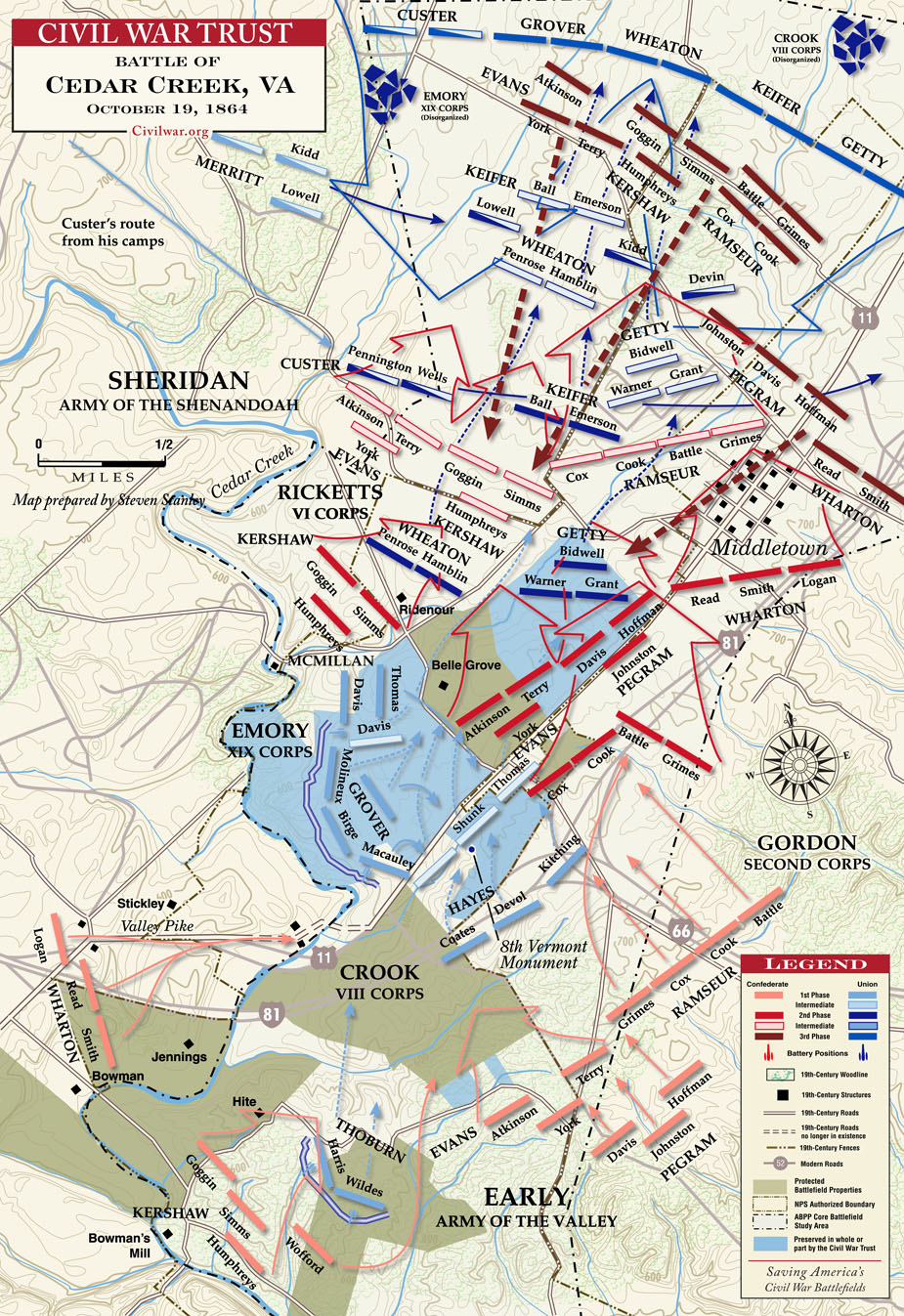
|
| Civil War Cedar Creek Map |
At the XIX Corps camps, General Emory reacted to the sounds of battle and
Crook's fleeing men entering his lines by reorienting his lines to face Gordon's oncoming attack. In doing so, he removed
a covering force that was protecting a bridge over Cedar Creek, allowing Wharton's column to move forward unimpeded at 5:40
a.m. Col. Wildes's brigade of Crook's army was ordered by Emory to stop its withdrawal, turn around, and attack the advancing
Confederates to buy more time for reorienting the Union lines. General Wright accompanied Wildes and received a painful wound
to his chin. The XIX Corps brigade of Col. Stephen Thomas made a similar gallant stand for over 30 minutes while McMillan's
division withdrew through the thin lines of Grover's division. These actions around Belle Grove delayed the Confederates enough
that most of the headquarters units and supply trains were able to withdraw to safety and the VI Corps could prepare a better
defense on the high ground just northwest of the plantation.
The three divisions of the VI Corps were able to establish proper defensive
lines. Kiefer's division aligned itself with Cedar Creek, but as retreating XIX Corps soldiers flowed through, they were unable
to hold their position and withdrew to just west of Meadow Brook. Elements of McMillan's division and Merritt's cavalry extended
their line to the west. At 7:15 a.m., Kershaw's Division hit the line hard, gradually forcing it back. Wheaton's division,
just to the north, was similarly forced back by Gordon's continued attack. The two Union divisions eventually linked up about
a mile to the northeast, joining with Getty's division, which was pulling back from a fierce fight at the Middletown cemetery.
Getty had originally marched his division toward the sound of battle, but when Wheaton withdrew, his men were unsupported.
Briefly defending a slight rise south of Middletown, at 8 a.m. he moved his division to the town cemetery, on a hill to the
west. For over an hour, Getty's division defended this position against assaults from four Confederate divisions. Jubal Early
assumed by the ferocity of the defense that he was fighting the entire VI Corps. He allowed himself to become distracted,
which diluted the momentum of the overall Confederate attack. Directing all of his artillery to concentrate on the cemetery
position for 30 minutes, he was able to dislodge Getty's division, ordered to withdraw to the main Federal line, now being
formed about a mile to the north, by temporary commander Brig. Gen. Lewis A. Grant. (The VI Corps' temporary commander, Brig.
Gen. James B. Ricketts, had been wounded and Getty assumed corps command.)
| Battle of Cedar Creek Map |
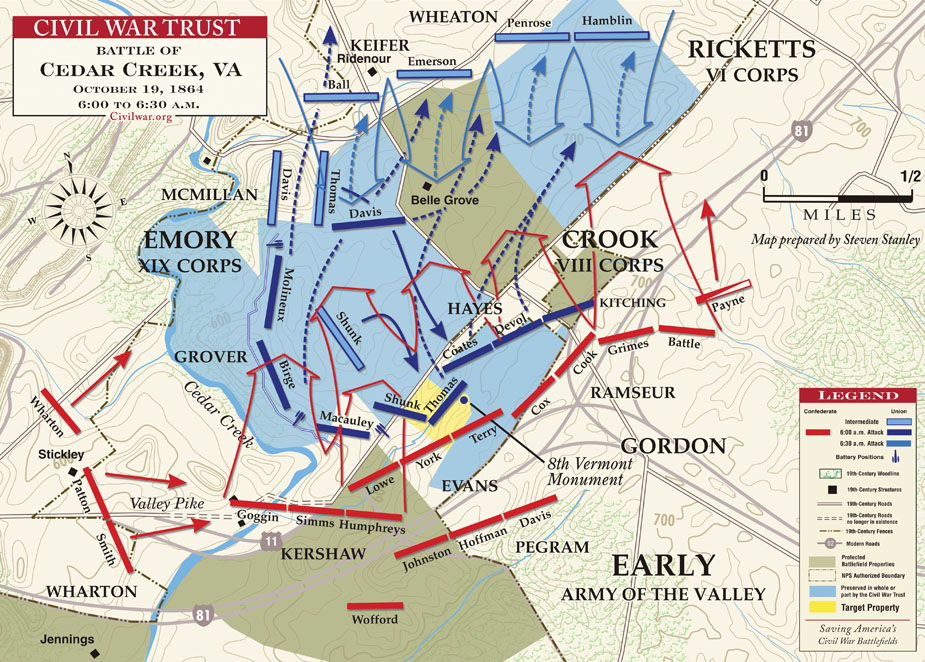
|
| (Morning) Battle of Cedar Creek |
Sheridan was at Winchester at the start of the battle. At 6 a.m., pickets
south of Winchester reported back that they heard the distant sounds of artillery. Not expecting any significant action from
Early that day, Sheridan dismissed the report. As additional reports arrived, he assumed it was "Grover's division banging
away at the enemy simply to find out what he was up to," but he ordered his horse, Rienzi, to be saddled and ate a quick breakfast.
At 9 a.m. he departed with three staff officers, and soon he was joined by a 300-man cavalry escort, and with them he rode
aggressively to his command. He noticed that the sounds of battle were increasing in volume quickly, so he inferred that his
army was retreating in his direction. At Newtown, he ordered a young officer from Crook's staff, Capt. William McKinley, to
set up a line that would intercept stragglers and send them back to the battlefield. He reached the battle about 10:30 a.m.
and began to rally his men to complete the defensive line north of Middletown that General Wright had begun to organize. His
presence electrified the Union soldiers and he shouted, "Come on back, boys! Give 'em hell, God damn 'em! We'll make coffee
out of Cedar Creek tonight!"
General Sheridan wrote in his official report an account of the famous ride:
[I] was unconscious of the true condition of affairs until about 9 o'clock,
when having ridden through the town of Winchester, the sound of the artillery made a battle unmistakable, and on reaching
Mill Creek, half a mile south of Winchester, the head of the fugitives appeared in sight, trains and men coming to the rear
with appalling rapidity. I immediately gave directions to halt and park the trains at Mill Creek, and ordered the brigade
at Winchester to stretch across the country and stop all stragglers. Taking twenty men from my escort, I pushed on to the
front, leaving the balance under General Forsyth and Colonels Thom and Alexander to do what they could in stemming the torrent
of fugitives. I am happy to say that hundreds of the men, when of reflection found they had not done themselves justice, came
back with cheers. ... still none behaved more gallantly or exhibited greater courage than those who returned from the rear
determined to reoccupy their lost camp.
| American Civil War Railroad Map |
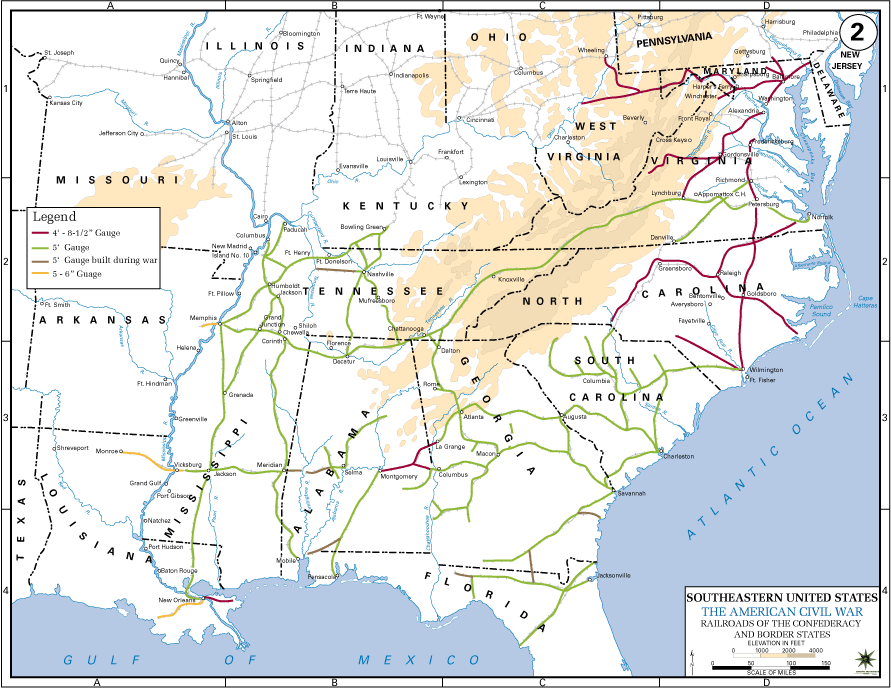
|
| Virginia Civil War Railroads Map |
Thomas Buchanan Read wrote a popular poem, Sheridan's Ride, to commemorate
Sheridan's exploit. The general took notice of the widespread public acclaim by renaming his horse "Winchester". In 1908,
Gutzon Borglum created an equestrian statue of Sheridan and Winchester riding to Cedar Creek, which stands in Sheridan Circle,
Washington, D.C.
Fortunately for Sheridan, Early's men were too occupied to take notice of the Union general's dramatic arrival; they
were hungry and exhausted and fell out of their ranks to pillage supplies from the Union camps. By 10 a.m., Jubal Early had
developed a stunning Confederate victory, capturing 1,300 Union prisoners, 24 cannons, and driving seven infantry divisions
off the field with a smaller force. But rather than exploiting his victory, Early ordered a halt in his offensive to reorganize,
a decision for which he later received criticism from his surviving subordinates. John B. Gordon wrote years later, "My heart
went into my boots. Visions of the fatal halt on the first day at Gettysburg, and of the whole day's hesitation to permit
an assault on Grant's exposed flank on the 6th of May in The Wilderness rose before me." Early wrote to Robert E. Lee, "So
many of our men had stopped in the camp to plunder (in which I am sorry to say that officers participated), the country was
so open, and the enemy's cavalry so strong, that I did not deem it prudent to press further, especially as Lomax had not come
up." The two armies stood about a mile apart in lines perpendicular to the Valley Pike. At 1 p.m. Early gave a halfhearted
order to Gordon to attack the Union line, but "not if he found the enemy's line too strong to attack with success." Gordon's
division moved forward against the XIX Corps, with Kershaw and Ramseur ready to support them, but after firing a heavy volley
into the Union line, they withdrew.
| Civil War Cedar Creek Battlefield Map |
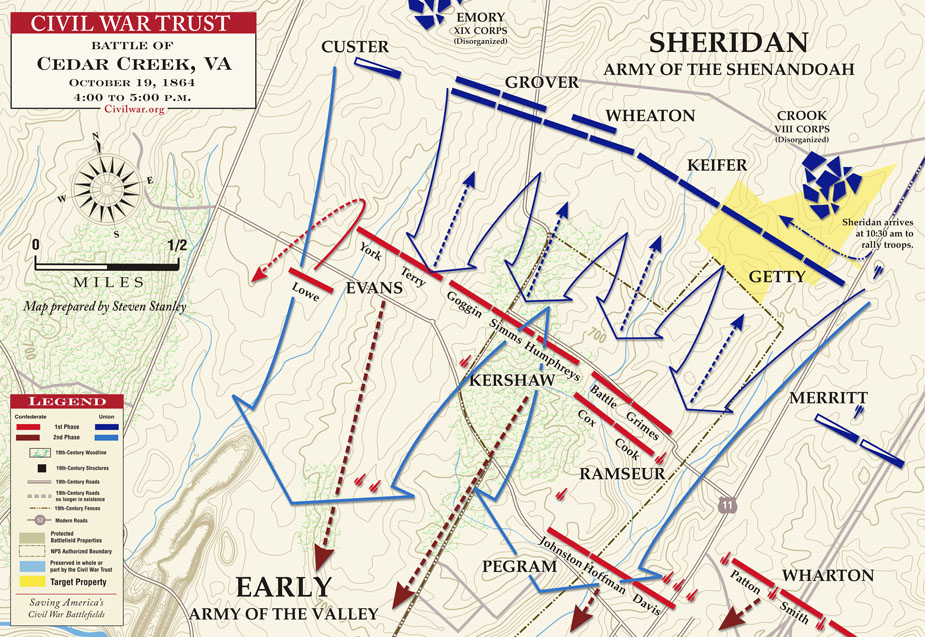
|
| (Evening) Battle of Cedar Creek |
Sheridan's boast about making coffee from Cedar Creek that evening means
that he was immediately contemplating a counterattack. He placed a cavalry division on each end of the line, which was made
up of Wright's VI Corps and Emory's XIX Corps. Crook's Army of West Virginia was in reserve. While his cavalry pressed both
of Early's flanks, Sheridan planned for the XIX Corps to execute a "left half-wheel" to the southeast, pivoting on Getty's
VI Corps division, and driving the Confederates into the Pike. The main attack began at 4 p.m., meeting significant Confederate
resistance north of Middletown for about an hour. Early's left flank began to crumble and Custer's cavalry raced into the
Confederate rear. Many of the Confederate soldiers panicked as they envisioned their escape route across Cedar Creek being
blocked by the Federal cavalrymen who had been so successful during the campaign. After the breakthrough on the Union right,
Sheridan stepped up the pressure with an attack on Ramseur's Division. General Ramseur was mortally wounded and his men joined
the retreat. Although the Confederate artillery made a few delaying stands along the way, Early had lost control of his army.
| Cedar Creek Civil War History |
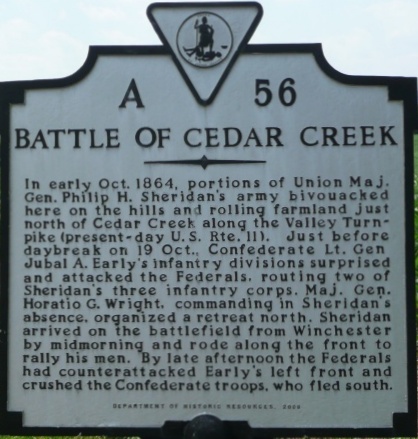
|
| Cedar Creek Battlefield |
| Battle of Cedar Creek History |
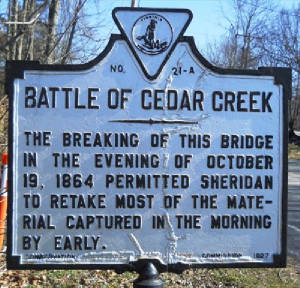
|
| Battle of Cedar Creek Historical Marker |
The situation worsened for the Confederates when a small bridge on the Valley
Pike collapsed, making it impossible to cross with wagons or artillery over "No Name Creek" south of Strasburg. Early's army
was forced to abandon all of the captured Union guns and wagons from the morning attack, as well as most of their own. Sheridan's pursuit ended at nightfall. The retreating Confederate soldiers gathered temporarily
on Fisher's Hill and then the army retired the following day to New Market.
Early's military career, moreover, effectively ended. His surviving units
returned to the Army of Northern Virginia in Petersburg that December. He was abandoned during the winter and commanded less than 3,000 men at Waynesboro. On March 2, 1865,
Sheridan marched his command to join Grant in the Siege of Petersburg -- while Custer's cavalry division routed Early's small command along the way. Early escaped with a small escort
and spent the next two weeks running from Federal patrols before reporting to Lee's headquarters. On March 30, Lee relieved
Early and sent him home.
Casualties: Casualties for the Union totaled 5,665 (644
killed, 3,430 wounded, 1,591 missing). Confederate casualties are only estimates, about 2,910 (320 killed, 1,540 wounded,
1,050 missing). In addition to the mortal wounding of Confederate general Ramseur (who died at Belle Grove in the company
of Union officers who were former colleagues and friends), two Union brigadier generals were killed at Cedar Creek: Daniel
D. Bidwell and Charles R. Lowell, Jr.
| 1864 Virginia Civil War Map |
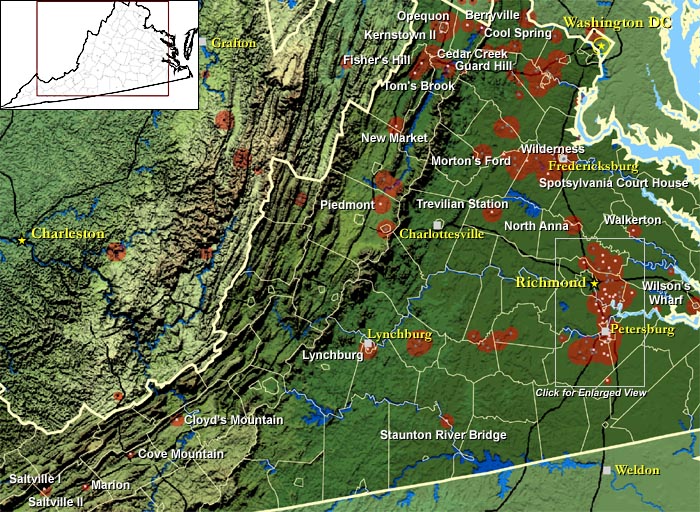
|
| Cedar Creek Battlefield Map |
Aftermath and Analysis: Nearly
all of Early's Confederate artillery was captured by the Union in the Battle of Cedar Creek. It was the last major battle
in the Shenandoah Campaign, and Early was never able to mount a serious offensive again.
Completing his missions of neutralizing Early and suppressing the Valley's
military-related economy, Sheridan
returned to assist Grant at Petersburg. Most of the men of
Early's corps rejoined Lee at Petersburg in December, while
Early remained to command a skeleton force. His final action was defeat at the Battle of Waynesboro on March 2, 1865, after
which Lee removed him from his command because the Confederate government and people had lost confidence in him. (Shenandoah Valley and the American Civil War and American Civil War in the Shenandoah Valley.)
| Gen. Stephen Dodson Ramseur |
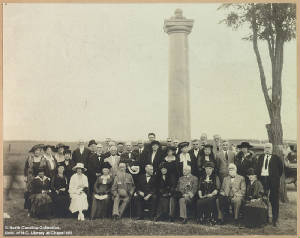
|
| Stephen Dodson Ramseur Monument |
After President Abraham Lincoln’s call for troops on April 15,
1861, most residents of the Shenandoah Valley joined their fellow Virginians in supporting secession of the Southern states
from the Union and establishing the Confederacy. A considerable number supported the Union and some remained indifferent. Wartime demands and war weariness increasingly alienated almost all elements
of society as they saw livestock taken by both sides, crops burned in the fields, and sons and husbands reported dead or missing.
Among the dissident elements were those of German ethnicity, many of whom were members of the region’s historic peace
churches who conscientiously objected to participation in war.
(Right) Maj. Gen. Stephen Dodson Ramseur Monument on Cedar Creek Battlefield. "Dod," as he was affectionately
called, was one of the youngest Confederate generals in the American Civil War. He was 27 years young
when he was mortally wounded at the Battle of Cedar Creek (May 31, 1837 – October 20, 1864). "Dod" had previously
fought in the following campaigns and battles: Seven Days Battles, Battle of Malvern Hill, Battle of Chancellorsville (Ramseur
was personally commended by "Stonewall" Jackson, who was mortally wounded at Chancellorsville, in a letter to General
Lee), Battle of Gettysburg, Battle of the Wilderness, Battle of Spotsylvania Court House, Battle of Cold Harbor, Battle of
Opequon (aka Winchester), and Battle of Cedar Creek.
During the early years of the war, the productive
granary in the Shenandoah Valley had served as the Breadbasket of the Confederacy, but regular conscriptions of food and livestock
had slowly impoverished local landowners. Displays of Confederate support included soldier recruitment, intelligence gathering,
provisioning of Southern units, and guerrilla activity against Union forces. The strategic as well as the agricultural importance
of the Lower Shenandoah meant that it became the locale of many skirmishes and battles, thus devastating the landscape and
leaving the area a wasteland at the war’s end.
On October 19, 1864, the
Confederates, under Lt. Gen. Jubal A. Early, surprised the Federal army at Cedar Creek and routed the VIII and XIX Corps,
implementing a masterfully conceived and brilliantly executed tactical plan. Sheridan arrived from Winchester, rallied his
troops, and in the afternoon, launched a crushing counterattack that succeeded in recovering the battlefield and in wresting
control of the Shenandoah Valley from the Confederates.
| Civil War Battle of Cedar Creek Battlefield Map |
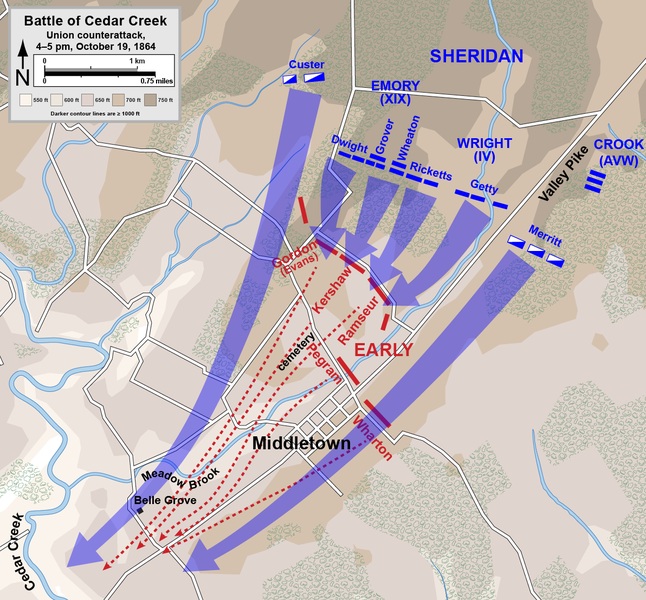
|
| Union Counterattack at Cedar Creek Battle Map |
| 1865 Virginia Civil War Map |
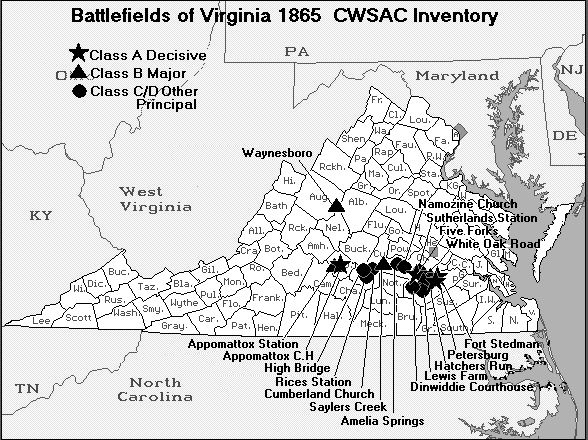
|
| Civil War Virginia Battlefield Map |
The Battle of Cedar Creek
was a crucial Union victory that nearly annihilated Early’s Confederate army and coupled with Sherman’s March
to the Sea helped Lincoln secure his reelection at a time when the northern populace was divided over the war. As a result
of the large-scale destruction of farms and mills during the Civil War, grain and livestock production declined drastically
in the Lower Shenandoah, recovering only by the early 20th century. At the same time, the Lower Shenandoah experienced a phenomenal
rise in apple production as apples and apple products replaced wheat as the primary cash crop.
Early had succeeded in tying down a large Federal force for several months,
thus helping Lee. However, at a moment of great opportunity he pulled back fatally. He had developed a risky plan which was
flawlessly executed, thus neutralizing the advantages held by his enemy. But instead of remaining with the logical consequences
of his high risk, he became conservative just as they were beginning to bear fruit. One critic said such a thing is common
when a general's moral courage is less than his strategic genius. Early's satisfaction with half a loaf and his fixation on
the Second Division, VI Corps perhaps indicate the limits of his grasp.
The lessons in leadership, command, cohesion, combined arms use, and the
performance of men under stress shown by this battle have a lasting value to all serious students of military history. Although
technology has overtaken the tactics used, the courage and professionalism of the combatants remains inspiring. The contribution
of the Second Division, VI Corps, one unit, stands as an example of the effect a single resolutely led force can have on a
battle's outcome. The same may be said of an individual, as seen by the effect of Sheridan's aggressive optimism on his whole
army.
On the other hand, the battle illustrates once again the consequences of
poor security and staff coordination. The Federal deaths, in the words of one Union officer, "were a high price to pay for
the failure to keep one's eyes open." The cool leadership in the face of disaster on the part of the senior Federal commanders
retrieved the situation and should stand as an inspiration to any leader in a dark hour.
Cedar Creek is a battle with many insights, foremost of which for an embattled
leader may be never to despair regardless of the situation. Jubal Early summarized the fight with the observation: "The Yankees
got whipped and we got scared."
The Battle of Cedar Creek spanned three Virginia counties: Frederick,
Shenandoah and Warren. While numerous battles were fought in Frederick County during the Civil War, adjacent Shenandoah
County witnessed the Battle of New Market on May 15, 1864, while the Battle of Front Royal took place in neighboring
Warren County on May 23, 1862.
Frederick County, furthermore, changed hands between the Confederate
and Union Armies on average once every three weeks during the Civil War. Many battles were fought in Frederick County. Some
of those battles include:
- First Battle of Kernstown, March 1862
- First Battle of Winchester, May 1862
- Second Battle of Winchester, June 1863
- Second Battle of Kernstown, July 1864
- Third Battle of Winchester, September 1864
- Battle of Cedar Creek, October 1864
The first constitution of West Virginia provided for Frederick County (home
to President George Washington for ten years) to be added to the new state if approved by a local election. Unlike those
of neighboring Berkeley and Jefferson counties (present-day West Virginia), Frederick County residents voted to remain in
Virginia despite being occupied by the Union Army at the time.
The aforementioned three counties were vital to both Union and Confederate
forces. The region was a major transportation and supply route through the Shenandoah Valley and was a major center
for crops. Advance to Shenandoah Valley Campaigns: The Civil War Battles.
| Virginia County Map |
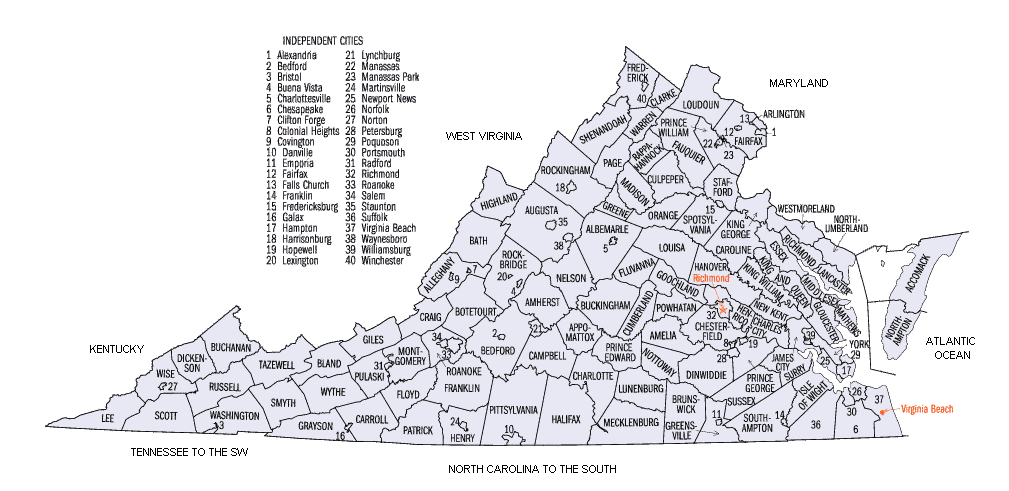
|
| Map of Virginia Counties |
Union Army Order of Battle
Army of the Shenandoah
Sheridan's Army of the Shenandoah consisted of 32,000 men (effectives)
and 90 artillery pieces.
VI Army Corps
1st Division
1st Brigade
4th New Jersey
10th New Jersey
15th New Jersey
2d Brigade
2d Connecticut Heavy Artillery
65th New York
121st New York
95th Pennsylvania
96th Pennsylvania
2d Division
1st Brigade
62d New York
93d Pennsylvania
102d Pennsylvania
139th Pennsylvania
2d Brigade
2d Vermont
3d Vermont
4th Vermont
6th Vermont
11th Vermont
Heavy Artillery
3d Brigade
1st Maine
43d New York
49th New York
77th New York
122d New York
61st Pennsylvania
3d Division
1st Brigade
14th New Jersey
106th New York
151st New York
184th New York
87th Pennsylvania
10th Vermont
2d Brigade
6th Maryland
9th New York Heavy
Artillery
110th Ohio
122d Ohio
126th Ohio
67th Pennsylvania
138th Pennsylvania
Artillery Brigade, Sixth Corps
5th Maine Artillery
1st NewYork
Artillery Battery
Batteries
C & G, 1st Rhode Island Artillery
Battery M, 5th US Artillery
Army of West Virginia
VIII Army Corps
1st Division
1st Brigade
34th Massachusetts
5th New York Heavy Artillery
116th Ohio
123d Ohio
3d Brigade
23d Illinois
54th Pennsylvania
10th West Virginia
11th West Virginia
15th West
Virginia
2d Division
1st Brigade
23d Ohio
36th Ohio
5th West Virginia
13th West Virginia
2d Brigade
34th Ohio
91st Ohio
9th West Virginia
114th West Virginia
Artillery Brigade, Eighth Corps
Battery L, 1st Ohio Light Artillery
Battery D, 1st Pennsylvania Reserve Light Artillery
Battery B, 5th US Artillery
Provisional Division (Col. Kitching)
6th New York Heavy Artillery
Miscellaneous Elements
XIX Corps
1st Division
1st Brigade
29th Maine
30th Massachusetts
90th New York
114th New York
116th New York
153d New York
2d Brigade
12th Connecticut
160th New York
47th Pennsylvania
8th Vermont
Division Artillery
5th New York Artillery
2d Division
1st Brigade
9th Connecticut
Battalion
12th Maine
14th Maine
26th Massachusetts
114th New Hampshire
75th New York
2d Brigade
13th Connecticut
3d Massachusetts
Cavalry (dismounted)
11th Indiana
Veteran
22d Iowa
131st New York
159th New York
3d Brigade
38th Massachusetts
128th New
York
156th New York
175th New York
176th New York
4th Brigade
8th Indiana
18th Indiana
24th Iowa
28th Iowa
Division Artillery
1st Battery,
ME Light Artillery
Battery
D, 1st Rhode Island Light Artillery
17th Battery, Indiana Light Artillery
Cavalry Corps
1st Cavalry Division
1st Brigade
1st Michigan Cavalry
5th Michigan
Cavalry
6th Michigan Cavalry
7th Michigan Cavalry
6th New York Battery
2d Brigade
4th New York Cavalry (HQs guard)
6th New York Cavalry
9th New
York Cavalry
19th New York
Cavalry
Batteries K & L,
5th US Artillery
Reserve Brigade
2d Massachusetts Cavalry
6th
Pennsylvania Cavalry (Army HQS)
1st US Cavalry
2d US Cavalry
5th US Cavalry
Division Artillery
6th Battery,
NewYork Light Artillery
Batteries
C & E, 4th US Artillery
2d Cavalry Division (Army of
West Virginia)
1st Brigade
22d Pennsylvania Cavalry
2d Brigade
1st New York Cavalry
1st West
Virginia Cavalry
2d West Virginia
Cavalry
3d West Virginia Cavalry
Division Artillery
Battery L, 5th US Artillery
3d Cavalry Division
1st Brigade
1st Connecticut
Cavalry
3d New Jersey Cavalry
2d NewYork Cavalry
5th NewYork Cavalry
2d Ohio
Cavalry
18th Pennsylvania Cavalry
2d Brigade
3d Indiana Cavalry
1st New
Hampshire Cavalry
8th NewYork
Cavalry
22d NewYork Cavalry
1st Vermont Cavalry
Horse Artillery
Batteries B
& L, 2d US Artillery
Batteries
C, F & K, 2d US Artillery
Confederate Army Order of Battle
Army of Northern Virginia
Early's Army of the Valley consisted of 21,000 men (effectives) and more than 40
artillery pieces.
2nd Corps
Rodes Division
Battle's Brigade
3d Alabama
5th Alabama
6th Alabama
12th Alabama
61st Alabama
Grimes' Brigade
32d North Carolina
53d North
Carolina
2d North Carolina
Battalion
43d North Carolina
45th North Carolina
Cook's Brigade
4th Georgia
12th Georgia
21st Georgia
44th Georgia
Cox's Brigade
1st North Carolina
2d North Carolina
3d North Carolina
4th North
Carolina
14th North Carolina
30th North Carolina
Kershaw's Division
Conner's Brigade
2d South Carolina
3d South
Carolina
7th South Carolina
8th South Carolina
15th South Carolina
20th South
Carolina
30th South Carolina
Battalion
Humphrey's Brigade
13th Mississippi
17th Mississippi
18th Mississippi
21st Mississippi
Wofford's Brigade
16th Georgia
18th Georgia
24th Georgia
3d Georgia Battalion
Cobb's (Georgia) Legion
Philip's (Georgia) Legion
Simms' Brigade
10th Georgia
50th Georgia
51st Georgia
53d Georgia
Pegram's Division
Pegram's Brigade
13th Virginia
31st Virginia
49th Virginia
52d Virginia
58th Virginia
Johnston's Brigade
5th North
Carolina
12th North Carolina
20th North Carolina
23d North Carolina
1st North
Carolina Sharpshooters
Goodwin's Brigade
6th North Carolina
21st North
Carolina
54th North Carolina
57th North Carolina
Gordon's Division
Evan's Brigade
13th Georgia
26th Georgia
31st Georgia
38th Georgia
60th Georgia
61st Georgia
12th Georgia Battalion
Hay's Brigade
5th Louisiana
6th Louisiana
7th Louisiana
8th Louisiana
9th Louisiana
Stafford's Brigade
1st Louisiana
2d Louisiana
10th Louisiana
14th Louisiana
15th Louisiana
Terry's Brigade
Remnants- 2d, 4th, 5th, 10th, 21st, 23d, 25th, 27th, 33d,
37th, 42d, 44th, 48th, 50th Virginia Regiments
Wharton's Division
Wharton's Brigade
45th Virginia
50th Virginia
51st Virginia
30th Virginia Battalion Sharpshooters
Echol's Brigade
22d Virginia
23d Virginia
26th Virginia
Battalion
Smith's Brigade
36th Virginia
60th Virginia
45th Virginia Battalion
Thomas's legion
Cavalry
Lomax's Cavalry Division
Imboden's Brigade
18th Virginia Cavalry
23d Virginia Cavalry
62d Virginia
Mounted Infantry
Johnson's Brigade
8th Virginia Cavalry
21st Virginia
Cavalry
22d Virginia Cavalry
34th Virginia Cavalry Battalion
36th Virginia Cavalry Battalion
McCausland's Brigade
14th Virginia Cavalry
16th
Virginia Cavalry
17th Virginia
Cavalry
25th Virginia Cavalry
Battalion
37th Virginia Cavalry
Battalion
Jackson's Brigade
2d Maryland Cavalry
19th Virginia
Cavalry
20th Virginia Cavalry
46th Virginia Cavalry Battalion
47th Virginia Cavalry Battalion
Rosser's Division
Wickham's Brigade
1st Virginia
Cavalry
2d Virginia Cavalry
3d Virginia Cavalry
4th Virginia Cavalry
Payne's Brigade
5th Virginia Cavalry
6th Virginia
Cavalry
15th Virginia Cavalry
Rosser's Brigade
7th Virginia Cavalry
11th Virginia
Cavalry
12th Virginia Cavalry
35th Virginia Cavalry Battalion
Artillery
Braxton's Brigade
Virginia
Battery (Carpenter's)
Virginia
Battery (Hardwicke's)
Virginia
Battery (Cooper's)
Cutshaw's Battalion
Virginia Battery (Carrington's)
Virginia Battery (Tanner's)
Virginia Battery (Garber's)
King's Battalion
Virginia Battery (Bryan's)
Virginia Battery (Chapman's)
Virginia Battery (Lowry's)
Carter's Battalion
Alabama Battery (Reese's)
Virginia
Battery (W. P. Carter's)
Virginia
Battery (Pendleton's)
Virginia
Battery (Fry's)
Nelson's Battalion
Georgia Battery (Milledge's)
Virginia Battery (Kirpatrick's)
Virginia Battery (Massdie's)
Horse Artillery
Maryland Battery (Griffin's)
Virginia Battery (Jackson's)
Virginia Battery (Lurty's)
Virginia Battery (McClanahan's)
Virginia Battery (Johnston's)
Virginia Battery (Shoemaker's)
Virginia Battery (Thompson's)
(Sources listed below.)
Sources: National Park Service; Library of Congress; Official Records of the Union and Confederate Armies; Civil
War Trust; Joseph W. A. Whitehorne, THE BATTLE OF CEDAR CREEK, Center of Military History - United States Army, Washington,
D.C., 1992; Bohannon, Keith S. "The 'Fatal Halt' Versus 'Bad Conduct':
John B. Gordon, Jubal A. Early, and the Battle of Cedar Creek." In The Shenandoah Valley Campaign of 1864, edited by Gary
W. Gallagher. Military Campaigns of the Civil War. Chapel Hill: University of North Carolina Press, 2006. ISBN 978-0-8078-3005-5;
Coffey, David. Sheridan's Lieutenants: Phil Sheridan, His Generals, and the Final Year of the Civil War. Wilmington, DE: Rowman
& Littlefield Publishers, 2005. ISBN 0-7425-4306-4; Cullen, Joseph P. "Cedar Creek." In Battle Chronicles of the Civil
War: 1864, edited by James M. McPherson. Lakeville, CT: Grey Castle Press, 1989. ISBN 1-55905-024-1. First published in 1989
by McMillan; Eicher, David J. The Longest Night: A Military History of the Civil War. New York: Simon & Schuster, 2001.
ISBN 0-684-84944-5; Gallagher, Gary W. "The Shenandoah Valley in 1864." In Struggle for the Shenandoah: Essays on the 1864
Valley Campaign, edited by Gary W. Gallagher. Kent, OH: Kent State University Press, 1991. ISBN 0-87338-429-6; Grimsley, Mark.
The Hard Hand of War. New York: Cambridge University Press, 1995. ISBN 0-521-59941-5; Kennedy, Frances H., ed. The Civil War
Battlefield Guide. 2nd ed. Boston: Houghton Mifflin Co., 1998. ISBN 0-395-74012-6; Lewis, Thomas A. The Guns of Cedar Creek.
New York: Harper and Row, 1988. ISBN 0-06-015941-3; Patchan, Scott C. "The Battle Of Cedar Creek, October 19, 1864." Blue
& Gray Magazine XXIV, no. 1 (2007); Salmon, John S. The Official Virginia Civil War Battlefield Guide. Mechanicsburg,
PA: Stackpole Books, 2001. ISBN 0-8117-2868-4; U.S. War Department. The War of the Rebellion: a Compilation of the Official
Records of the Union and Confederate Armies. Washington, DC: U.S. Government Printing Office, 1880–1901; Welcher, Frank
J. The Union Army, 1861–1865 Organization and Operations. Vol. 1, The Eastern Theater. Bloomington: Indiana University
Press, 1989. ISBN 0-253-36453-1; Wert, Jeffry D. From Winchester to Cedar Creek: The Shenandoah Campaign of 1864. New York:
Simon & Schuster, 1987. ISBN 0-671-67806-X; Whitehorne, Joseph W. A. The Battle of Cedar Creek: Self-Guided Tour. rev.
ed., Middletown, VA: Cedar Creek Battlefield Foundation, 2006. First published as The Battle of Cedar Creek: Self-Guided Tour.
Washington, DC: United States Army Center of Military History, 1992. ISBN 978-0-16-026854-0.
|

